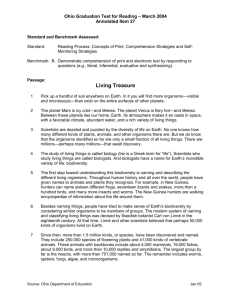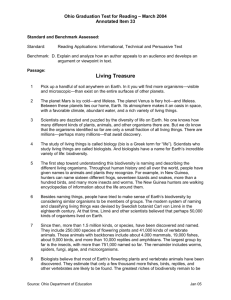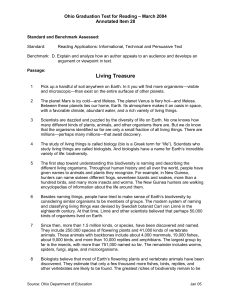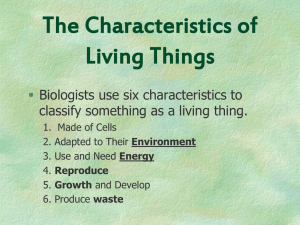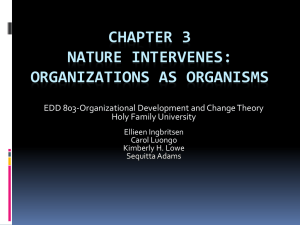How Many Species Are There?
advertisement
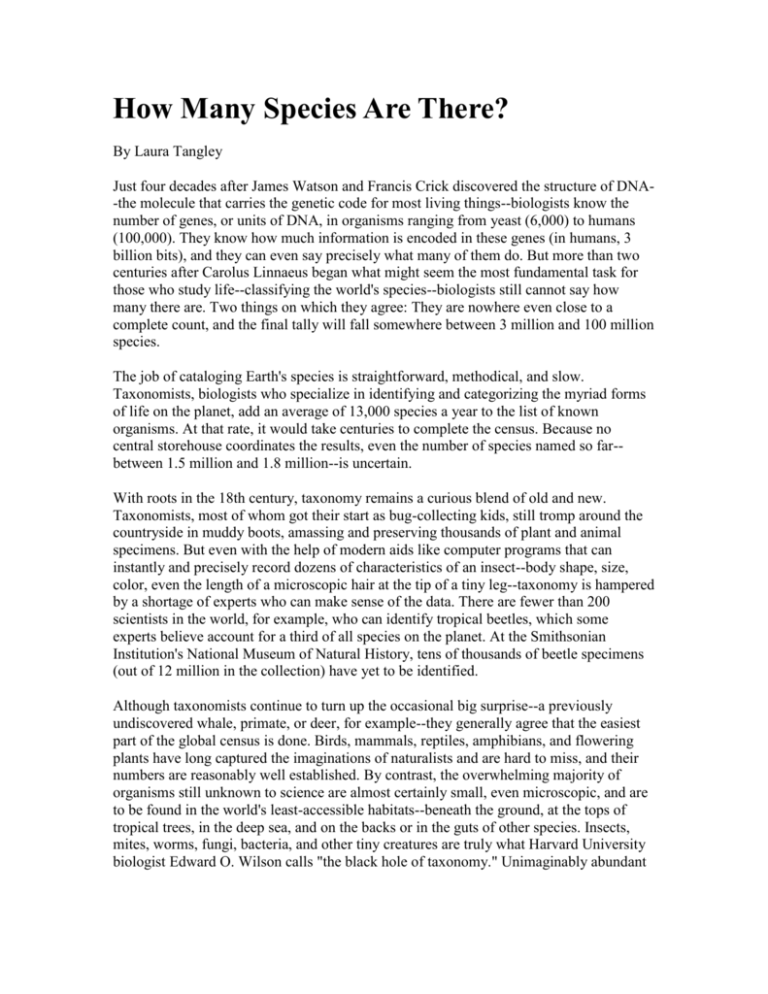
How Many Species Are There? By Laura Tangley Just four decades after James Watson and Francis Crick discovered the structure of DNA-the molecule that carries the genetic code for most living things--biologists know the number of genes, or units of DNA, in organisms ranging from yeast (6,000) to humans (100,000). They know how much information is encoded in these genes (in humans, 3 billion bits), and they can even say precisely what many of them do. But more than two centuries after Carolus Linnaeus began what might seem the most fundamental task for those who study life--classifying the world's species--biologists still cannot say how many there are. Two things on which they agree: They are nowhere even close to a complete count, and the final tally will fall somewhere between 3 million and 100 million species. The job of cataloging Earth's species is straightforward, methodical, and slow. Taxonomists, biologists who specialize in identifying and categorizing the myriad forms of life on the planet, add an average of 13,000 species a year to the list of known organisms. At that rate, it would take centuries to complete the census. Because no central storehouse coordinates the results, even the number of species named so far-between 1.5 million and 1.8 million--is uncertain. With roots in the 18th century, taxonomy remains a curious blend of old and new. Taxonomists, most of whom got their start as bug-collecting kids, still tromp around the countryside in muddy boots, amassing and preserving thousands of plant and animal specimens. But even with the help of modern aids like computer programs that can instantly and precisely record dozens of characteristics of an insect--body shape, size, color, even the length of a microscopic hair at the tip of a tiny leg--taxonomy is hampered by a shortage of experts who can make sense of the data. There are fewer than 200 scientists in the world, for example, who can identify tropical beetles, which some experts believe account for a third of all species on the planet. At the Smithsonian Institution's National Museum of Natural History, tens of thousands of beetle specimens (out of 12 million in the collection) have yet to be identified. Although taxonomists continue to turn up the occasional big surprise--a previously undiscovered whale, primate, or deer, for example--they generally agree that the easiest part of the global census is done. Birds, mammals, reptiles, amphibians, and flowering plants have long captured the imaginations of naturalists and are hard to miss, and their numbers are reasonably well established. By contrast, the overwhelming majority of organisms still unknown to science are almost certainly small, even microscopic, and are to be found in the world's least-accessible habitats--beneath the ground, at the tops of tropical trees, in the deep sea, and on the backs or in the guts of other species. Insects, mites, worms, fungi, bacteria, and other tiny creatures are truly what Harvard University biologist Edward O. Wilson calls "the black hole of taxonomy." Unimaginably abundant and largely unknown, their numbers could change species totals by a factor of 10 or more. Bootstrap estimates. Flying blind when it comes to real numbers, biologists have devised several methods to estimate global species diversity. The simplest rely on ratios of known to unknown organisms. For well-cataloged groups such as birds and mammals, for example, researchers have found about twice as many species in the tropics as in the temperate zone. Assuming that a similar ratio holds true for all living things, some scientists calculate that the 1.5 million to 1.8 million species named so far--two thirds of them from the temperate zone--translates to 3 million to 5 million species total. Another technique is based on a well-established relationship between an animal's body size and its abundance: There are a lot more small animals than large ones. Roughly speaking, for each 10-fold decrease in body length, the number of species increases by a factor of 100. Taxonomists have tested and confirmed the rule all the way down to animals about a centimeter long. If the same relationship holds true for the tiniest creatures visible to the naked eye--those about a millimeter long--then known numbers of animals such as mammals, reptiles, and amphibians imply a worldwide total of about 10 million species of all land-dwelling animals. By far the largest estimate of species numbers comes from a third methodology that begins with a take-no-prisoners census of a single site. In a pioneering experiment conducted five years ago in Panama, Smithsonian entomologist Terry Erwin fogged the tops of 19 Leuhea seemannii trees with a powerful, biodegradable insecticide and collected the rain of insects that poured down from the ordinarily inaccessible canopy. Over the course of three seasons, he and his colleagues found 1,200 different kinds of beetles alone. Erwin, an expert on tropical beetles, figured that about 160 of these species were "host specific"--that is, they lived nowhere but in the tops of Leuhea seemannii. Beetles account for two fifths of known insects, so he then speculated that the tree's canopy housed 400 host-specific insects of all kinds. Because about two thirds of tropical forest insects live in the canopy, Erwin next assumed that 600 insect species inhabited all parts of the tree. Finally, noting that there are about 50,000 tropical tree species worldwide, Erwin multiplied 600 by 50,000 and came up with a grand total of 30 million insect species. More recently, he has collected beetles from forests in Peru, Ecuador, and Brazil, and from a preliminary analysis of these samples, he now says that 30 million is too conservative a number. Based on Erwin's findings, others have suggested that overall species totals may approach 100 million. Armchair biology. All these estimates, of course, are the product of actual observations multiplied by total guesswork. When it comes to Earth's smallest animals, for example, the true relationship between body size and abundance might actually be the opposite of what the calculations assume: Because tiny creatures are more easily and widely spread by wind or water, single species may each occupy vast ranges, which could mean that the number of species decreases with decreasing size. Erwin admits that extrapolating from a single sample to the whole world is a huge stretch but defends his numbers for at least being based on real experimental data. This is in contrast with a United Nations-sponsored "consensus" effort that surveyed the world's leading experts on every group of living organisms, from bacteria to mammals, and came up with a suspiciously precise "working estimate" of 13.6 million species. ("Armchair biology," says Erwin.) Estimates themselves may be a way of ducking the issue, though: If you want to know how many species there are, the only thing to do is go out and count them, one by one. Driven by concerns over rampant habitat destruction and species extinction, many scientists over the past decade have called for a comprehensive global biological survey that, in addition to counting species, would name and describe them. Harvard's Wilson, one of the strongest advocates of such an effort, says it could take 30 to 50 years and cost a few billion dollars (much of it for training taxonomists). A few iconoclasts say counting species itself ducks the real issue. "It does not matter how many species there are," flatly asserts University of Pennsylvania biologist Daniel Janzen. "Whether it is 10 million or 30 million is neither relevant to their conservation nor a reflection on whether the science is good or bad." He says biologists concerned with the "pseudoscience" of answering the question suffer from "some sort of distorted physics envy." Less caustic critics point out that categorizing life in terms of species is itself somewhat arbitrary. The most widely used definition of a species is a group of organisms that breed freely with one another in nature and produce viable offspring. Yet for many organisms-particularly those yet to be discovered--sex is irrelevant. "We have no proof how most living things reproduce in the wild," says David Hawksworth, president of the International Union of Biological Sciences. Such creatures include many fungi, the organisms he studies, which Hawksworth estimates number at least 1.5 million different kinds. Even avid species counters concede that coming up with a grand total would not be the most important result of a global biological survey. More disturbing than our uncertainty about the magnitude of life on Earth, they say, is our ignorance about organisms that we have identified. For most of these living things--which provide humans with food, clothing, shelter, medicine, and the environmental conditions that sustain all life--we have no more than a technical name, a collection site, and a few dead specimens in a museum drawer. One for the beetles. If an organism's size reflected the number of species in its group, this is what the world would look like. About 1.5 million to 1.8 million species have been identified to date, and about 13,000 new ones are added to the list each year. But experts estimate the actual total to be anywhere from 3 million to 100 million. (The figures in this graph are plotted on a logarithmic scale.) Mammals 4,000; Amphibians 4,200; Echinoderms (starfish and relatives) 6,100; Reptiles 6,300; Birds 9,000; Earthworms 12,000; Fishes and lower chordates 18,800; Algae 26,900; Protozoa 30,800; Mollusks 50,000; Fungi 69,000; Noninsect arthropods (crustaceans, spiders, etc.) 123,400; Plants 248,000; Insects 751,000 Reading Questions: 1. When it comes to classifying the world’s species, what two things do biologists agree upon? 2. What is a taxonomist? How many species do they add to the list of known organisms each year? 3. What is taxonomy hampered by? 4. What type of organisms make up the majority of organisms still unknown? 5. Biologist Edward O. Wilson is quoted as saying “the black hole of taxonomy”. What does he mean by this? 6. Describe the various methods biologists have derived to estimate global species diversity. (hint: there are 3 methods) 7. What did Terry Erwin do? 8. How many species of Mollusks have been identified? 9. If an organism’s size reflected the number of species in its group, what would the world look like? 10. Explain armchair biology. 11. Scientists have called for a comprehensive global biological survey. What would this accomplish? What would be the cost? 12. What is more disturbing than our uncertainty about the magnitude of life on Earth? 13. Do you believe that accurately knowing the number of species on the planet is important or irrelevant? Explain why.

